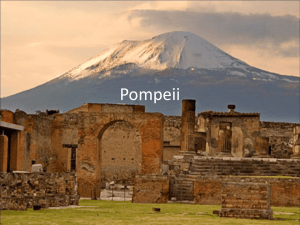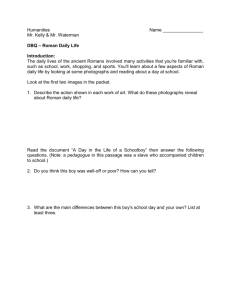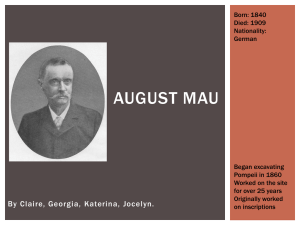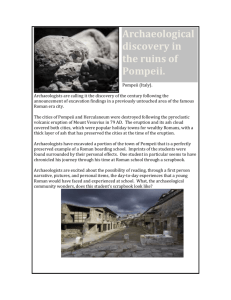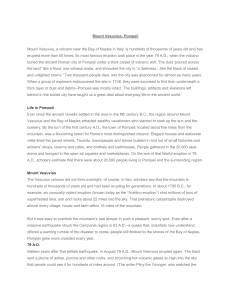Recent articles 2012 - failed conservation
advertisement
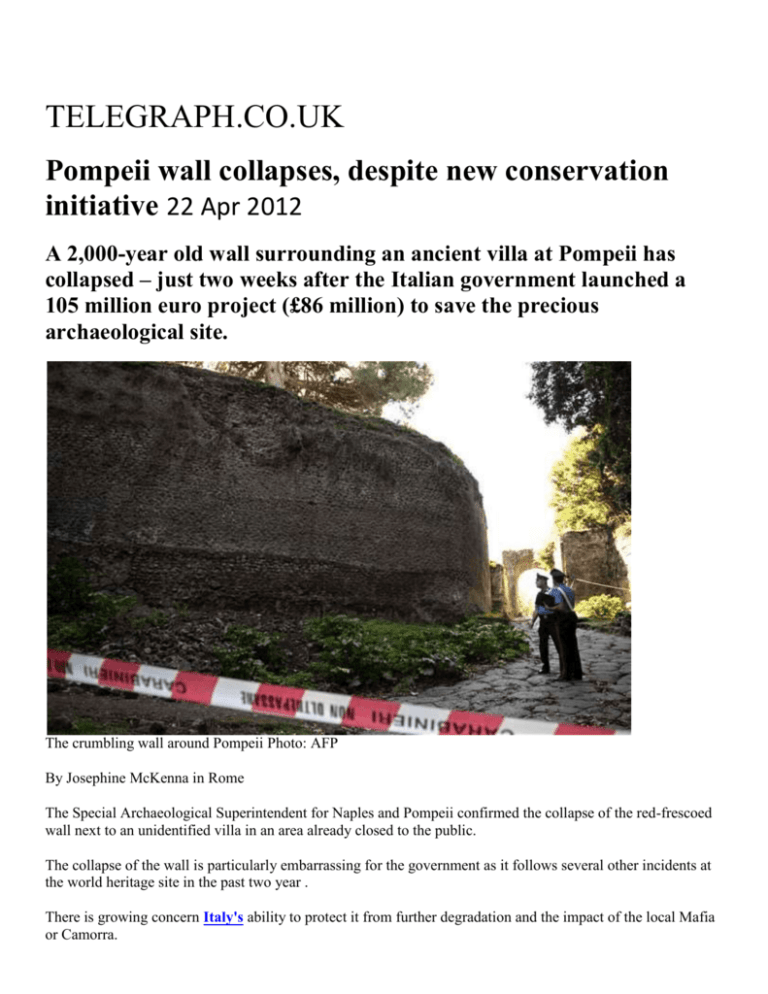
TELEGRAPH.CO.UK Pompeii wall collapses, despite new conservation initiative 22 Apr 2012 A 2,000-year old wall surrounding an ancient villa at Pompeii has collapsed – just two weeks after the Italian government launched a 105 million euro project (£86 million) to save the precious archaeological site. The crumbling wall around Pompeii Photo: AFP By Josephine McKenna in Rome The Special Archaeological Superintendent for Naples and Pompeii confirmed the collapse of the red-frescoed wall next to an unidentified villa in an area already closed to the public. The collapse of the wall is particularly embarrassing for the government as it follows several other incidents at the world heritage site in the past two year . There is growing concern Italy's ability to protect it from further degradation and the impact of the local Mafia or Camorra. Giulia Rodano, cultural affairs spokesman for the centre-left Italy of Values party, said there was a need to restore state funding that had been eroded by government cutbacks. "How many walls have to fall, how much rain or snow should we expect to see a turnaround in state finance for the protection of cultural assets," Ms Rodano said. "Without a continuous state programme for the conservation and restoration of our archaeological sites, extraordinary and sporadic intervention with European or private funds risks being ineffective." The latest initiative launched in early April is funded by Italy and the European Union. At the launch Mario Monti, the Italian prime minister, said the project was designed to secure the buildings currently at risk in one of the most important cultural site in the world. "We want to ensure that this is accomplished through honest and capable workers and companies while keeping away the organised crime that is still strong in this area," he added. Pompeii was destroyed when a volcanic eruption from nearby Mount Vesuvius buried the city in ash in 79AD and it now attracts more than 2.5 million visitors a year. The site has fallen victim to various collapses in the last few years, prompting criticism from both Unesco and the European Union. Pompeii column collapses, renewing concerns about state of site 9:04PM GMT 22 Dec 2011 A courtyard column of a Roman house in Pompeii has collapsed, renewing concerns about the state of the 2,000 year-old site. The house where Loreio Tiburtino, a Roman nobleman, lived Photo: EPA Last year the Italian government was accused of neglecting the Unesco World Heritage site near Naples in southern Italy when part of the "House of the Gladiators" fell down. That collapse, along with three others in 2010, and the subsequent accusations of neglect and mismanagement, helped trigger a no-confidence vote against former culture minister Sandro Bondi in January. Mr Bondi, a member of former Prime Minister Silvio Berlusconi's centre-right government, survived the vote but quit in March. Officials said the latest part of the site to crumble was one of several columns that once held up wooden trellises in the house where Loreio Tiburtino, a Roman nobleman, lived. Built in the second century BC, the house was renovated in 62AD, 17 years before the cataclysmic eruption. "This is a torment without end," said Luisa Bossa, a lawmaker from the leftist opposition Democratic Party and former mayor of the Naples-area town of Herculaneum, also a major Roman-era archeological site. "We have been complaining for three years but the country's most important archeological area continues to fall apart. The truth is that the site has been left alone for years and now, a bit at a time, we are paying the price," she said. She called on Italy's culture minister, Lorenzo Ornaghi, to "take stock of the gravity of the situation and confront it with determination and speed". Italy's archaeologists also voiced their concerns. "To overcome the emergency created by these collapses, we need to hire specialised maintenance workers straight away. That is the only possible cure for Pompeii," Tsao Cevoli, head of the National Archaeologists Association, told news agency Ansa. Pompeii was home to about 13,000 people when it was buried under ash, pumice pebbles and dust in 79AD as it endured the force of an eruption equivalent to 40 atom bombs. Two-thirds of the 165-acre town has since been uncovered. Pompeii attracts some 2.5 million tourists each year, making it one of Italy's most popular attractions. Pompeii ruin collapses amid claims site mismanaged A 2,000-year-old ancient Roman house used by gladiators before fighting to the death has collapsed in the buried city of Pompeii, further fuelling claims the site is badly managed. The collapsed house in the ancient Roman city of Pompeii once used by gladiators to train before combat Photo: AP By Nick Pisa in Rome 4:32PM GMT 07 Nov 2010 The stone house, known as Schola Armaturarum Juventus Pompeiani, crumbled into a pile of rubble and dust in the early hours of Saturday morning before visitors were allowed in. Although the house is closed to the public, it was a popular site in the city – buried by an eruption from nearby Mt Vesuvius in AD79 – because of its beautiful gladiator frescoes painted on the outside walls. Pompeii, south of Naples is a unique historical site and is on the UNESCO World Heritage list but for decades it has been allowed to fall into ruin and disrepair. Today more than 250 years after it was discovered, 40% of the city – which if fully excavated would give a unique insight into ancient Roman life – is closed or yet to be examined. Italy's president Giorgio Napolitano called the collapse "a shame" and it came after an expose last month by newspaper Corriere della Sera that said Pompeii was an international embarrassment because of the mismanagement. Officials at the site have blamed the collapse on a lack of funds but the Culture Minister Sandro Bondi insisted after visiting Pompeii on Sunday that funds were adequate and management were to blame. Minister Bondi added that if there was any evidence that he "was responsible" then he would resign saying: "I stand by the work that has been done here." He said the probable cause was rain water that had infiltrated the House of the Gladiators when it was restored with cement at the end of the Second World War after suffering bomb damage. Officials said they were "hopeful" that the frescoes could be saved with Professor Christopher Smith, the director of the British School in Rome which carried out digs across Italy offering his help and knowledge. Professor Smith, has not worked at Pompeii but the School is known for its dig at nearby Herculaneum which was also buried in the same eruption of Mt Vesuvius and is much better preserved and maintained. Professor Smith said: "It's extremely sad to see what has happened at Pompeii, which is clearly suffering problems from its maintenance. Pompeii is a site of world heritage and we would be more than happy to offer our experience. "Archeological sites are always at risk when they are open to the elements but the problems at Pompeii have been going back for decades and our experience is that you need a good plan for maintenance and administration." Professor Smith added: "Unless there is a proper plan put into action I'm very sad to say that we will see this sort of thing happen again – buildings that are at risk must be secured or they will collapse." On Sunday the site – which has more than two million visitors a year – was open to the public but TV footage showed many buildings held up by rickety-looking scaffolding, roped off or closed with wrought iron gates. In 2008 Silvio Berlusconi's government put just over two billion euros aside for heritage conservation but this year it was cut to 1.7 billion in a bid to save money – with two million euros earmarked for Pompeii. Two years ago the government declared a state of emergency for Pompeii and it lasted until 2009 with extra funds and special measures but critics have said the special intervention was badly managed. Historians said that collapsed building would have been the residence for gladiators in Pompeii. It would have been where they trained and relaxed before fighting in the nearby arena, and trophies would have been on display. The collapse of the House of the Gladiators comes just eight months after part of the Domus Aurea, or Nero's Golden Palace, crumbled in the centre of Rome, again after rain infiltration. Pompeii 'a symbol of Italy's sloppiness' For visitors to Pompeii, they are a guaranteed crowd pleaser: erotic frescoes, including one of Priapus, the god of fertility, adorning the walls of a 2,000 year old Roman villa. By Nick Squires in Pompeii 9:00PM BST 10 Oct 2010 Or rather they were until two years ago, when the House of the Vettii closed for a restoration project which was supposed to last a year but which still grinds on, the villa encased in scaffolding and a sign outside offering no indication of when it might reopen. Pompeii may be the best preserved Roman city in the world, thanks to the volcanic ash from nearby Mt Vesuvius which smothered it after a catastrophic eruption in AD79, but critics say years of neglect and indifference have turned it into an international embarrassment and an emblem of the dysfunction which plagues so much of Italian public life. Exquisite frescoes are scarred with modern graffiti, weeds are growing out of painted walls and there is a dearth of interpretive signs. Many of the most famous villas in the city are padlocked behind signs reading "Lavori in corso" – Work in Progress – while the city's most gruesome but irresistible attractions, the plaster casts of ancient Romans who perished in the searing hot ash and pumice emitted by Vesuvius, are displayed in dusty glass cabinets standing on rusted metal legs. The sense of crisis came to a head last week when the respected broadsheet, Corriere della Sera, ran a frontpage editorial under the headline "The humiliation of Pompeii". "The fact is that this archeological area, which is unique in the world, is unfortunately the symbol of all the sloppiness and inefficiencies of a country that has lost its good sense and has not managed to recover it," the editorial said. The editorial sparked a political row, with the Italian government of Silvio Berlusconi and the opposition blaming each other for Pompeii's shambolic state. Nicola Cosentino, a close ally of Mr Berlusconi and a regional coordinator for the governing party, said Pompeii was "like a souk" when the government came into power two years ago. But Luisa Bossa, an MP with the opposition Democratic Party, said thousands of tourists witnessed the "decay and abandonment" of Pompeii every day. "The site is on its last legs. It is a symbol of the fact that this government cares nothing for Italy's heritage." Around two million visitors a year pay 11 euros each to visit the site, generating annual revenue of around 20 million euros, but archaeologists say it is not sufficient to fund the unending task of restoring and maintaining the site. The Berlusconi government has also made deep cuts to arts and heritage funding – the amount of money allotted to the maintenance of ancient sites has dropped from 30 million euros in 2007 to just under 19 million this year. But Salvatore Settis, a former president of the government's heritage committee, said blame could not be assigned only to the current government. "Parties on both sides have completely marginalised culture and heritage," he said. Andrew Wallace-Hadrill, a British professor of archaeology who has worked at Pompeii and nearby Herculaneum for more than 20 years, said it was overly simplistic to pin the blame on Italian inefficiency and in-fighting. "The fundamental reason why there are such enormous problems is the scale and complexity of the site," said Prof Wallace-Hadrill, now the master of Sidney Sussex College at Cambridge University. The Italian government is believed to be working on the establishment of a foundation which would invite private donors to give money to help preserve Pompeii, possibly in return for advertising opportunities – just as a similar scheme was launched this summer to save the crumbling Colosseum in Rome.
